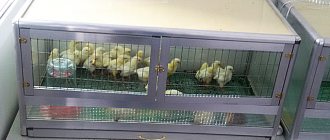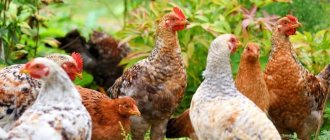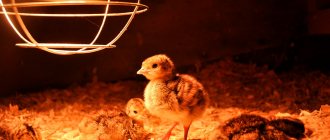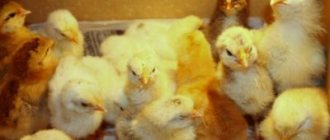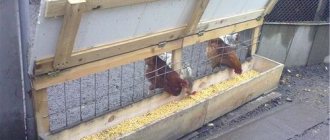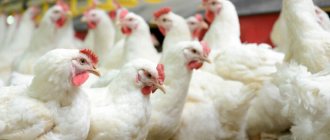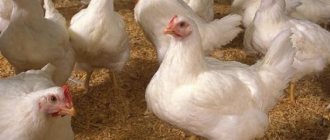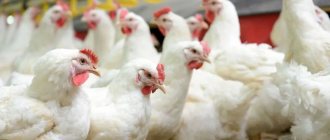In the first month, the still immature chicks need special conditions. And first of all, in creating a temperature regime. For this purpose, an electric, fluorescent, LED, ultraviolet or infrared lamp for chickens is used. When installing such devices, it is worth considering that each type has certain technical characteristics. This, as well as the advantages and disadvantages of different lamps, will be discussed in the article.
Conditions for keeping chickens
Influence of light regime
Raising young animals primarily involves creating the necessary lighting and temperature. Moreover, the indicators vary depending on the age of the chicken. This is necessary for its normal development and growth.
The longer the daylight hours, the more positively it affects the growth of the chick’s live weight. And on the tone of his body.
This is explained by the fact that light rays hitting the retina of a bird's eyes cause nerve impulses. They, in turn, stimulate physiological processes in their body.
It is worth considering that increased illumination leads to cannibalism among chicks. Therefore, it is better to create additional lighting in the chicken coop from automatically controlled lamps.
Where to keep
To avoid losing hatched flocks, you should prepare and equip a brooder for chicks in advance. This is a kind of quadrangular box made of thick plywood or tongue and groove boards.
To keep 30 chickens, the brooder must have the following dimensions: width - 70 centimeters, length - 20 centimeters, height - 45 centimeters.
If you want to save money but save the chicks, we recommend that you read the article “Building a brooder for chickens with your own hands.”
How to preserve livestock
The floors of the brooder should be covered with sawdust mixed with peat. Also, a house for chicks should include a heater, lighting, a ventilation system, a feeder and a drinking bowl.
More detailed information is described in the article “Rules for keeping chickens in a brooder: temperature and other parameters.”
Also, young animals need to be provided with properly balanced nutrition, timely cleaning and disease prevention. The article “Collecting a veterinary first aid kit for chickens” will tell you more about the latest measures.
Temperature indicators
The first days of the chickens’ life, the temperature in the keeping room should be +35 degrees.
After three days, the air temperature should be reduced to +30 degrees. This temperature in the chicken coop is maintained until the chickens reach one month of age.
Starting from the second month of life of the chicks, the temperature should be gradually reduced to comfortable degrees. Find out more in the article “Temperature conditions for chickens in the first days of life.”
Failure to comply with temperature conditions
Negligence can lead to hypothermia of chickens. And, as a result, they develop various diseases.
Too high a room temperature will promote the development of bacteria that have a negative impact on the health of the young.
Also, failure to comply with temperature requirements reduces the bird’s appetite and slows down its development. And often leads to death. Therefore, it is important to create adjustable heating for the chickens in the coop.
Cold or hot
To determine whether chickens are cold or hot at home, you need to pay attention to their behavior. If the chicks are hot, they are placed as far as possible from the heaters. They have a lethargic appearance and sleep on the move. They constantly drink water, refusing to eat.
If the chicks are cold, they are placed closer together. They make noise, outraged by the situation. They sleep next to the feeder. In a neglected situation, they lead a quiet, sedentary lifestyle.
When babies feel comfortable
At a comfortable temperature, the young animals are mobile. Chicks run around the entire perimeter of the brooder and do not accumulate at feeders and drinkers. They also produce a pleasant chirping sound.
If you learn to determine the comfortable temperature “by eye,” you can quickly find your bearings. And choose the right heater lamp for chickens.
But it is worth considering that each type of lamp has disadvantages, advantages and rules of use.
Before purchasing a particular lamp, you should familiarize yourself in detail with its characteristics presented below.
Construction
Building a winter chicken coop with your own hands begins with the foundation. There are several optimal options.
Pile is the cheapest and easiest to implement. The weight of screw piles is small, so one person can install them. The screw blades in the form of empty metal pipes are 2.5 meters long and can be easily screwed into any soil, and installing such a foundation will not take more than an hour. The area needs to be marked according to the size of the future chicken coop. It is best to do this using a rope with pegs. Next, you need to mark the places where the piles will stand. First you should screw in those that will be in the corners of the room, and then all the rest. The piles should be installed at a distance of one and a half or two meters.
Columnar is also good for its efficiency and ease of installation. It can be done without much knowledge or experience. The installation begins by marking with a rope and pegs, then along the perimeter you need to dig holes 50x50 cm wide and 60–70 cm deep. The recesses should be located at a distance of about a meter, about 10 cm deep the holes are filled with a mixture of sand and gravel, then they are well compacted. A brick is placed on top of the cushion and the whole thing is filled with concrete mortar. You need to fill until the level along the stretched rope is reached. When the bases are ready, you can install cabinets or pillars on them. It is imperative that they be 25 centimeters or more above the level. After this, you can fill the area with gravel.
The tape type is difficult to implement, but its reliability is undeniable. To do this, you first need to dig around the perimeter of the poultry house. Then formwork is made, preferably from boards, and filled with concrete
In this case, it is important to adhere to the technology, the intricacies of which can be found out from specialists.
Of course, a chicken coop with a strip foundation takes a little longer to build, since the concrete will have to harden before the main construction work. For example, the construction of a building made of wood can only begin 21 days after pouring, and that of brick – after 28–35 days. The first two foundation options are good because they can create additional ventilation. With them in winter there will be no problems with rotting floors. In addition, during the spring flood period, the chicken coop will not be flooded.
When the foundation is ready, you can continue to build the winter chicken coop according to the selected drawing. The actual construction begins with the installation of the floor. First you need to build a so-called support frame, which is covered with boards from the bottom. Then logs are made at a distance of 50 centimeters. It is desirable that their cross-section be 100x150 centimeters.
Next, they move on to the construction of walls. If they are made of timber, then jute fiber must be laid between them, which is necessary to eliminate cracks. For walls made of OSB, you first need to make a frame of beams arranged in a grid. The walls must be sheathed on both sides to be able to fill them with insulation.
Windows and doors need to be made during the construction of walls
When installing, it is important to check their reliability and the absence of cracks. An important point is ventilation, which is easily organized using the simplest pipe
The penultimate touch is the roof, which can be pitched or gable. It is necessary to take care of its waterproofing, for which roofing felt is suitable. The last point is the creation of artificial light and the interior arrangement of the barn
It is important that chickens and moisture cannot reach the wires. It is best to place them in special plastic boxes
You need to lay a mat on the floor with a height of 7 centimeters. A beam with a diameter of about 6 centimeters is perfect for perches. Perches with a total length of 1.7 meters are enough for 10 chickens. Nests measuring 50x50 cm can be made from any materials, for example, wood, old tires. The main thing is that there are at least two of them. Drinkers and feeders can be wall-mounted or floor-mounted. The main thing is that the chickens feel comfortable using them. The very last thing you need to do with your own hands is to build an enclosure.
Electric lamp
pros
In addition to light, an electric lamp is considered a source of heat. Therefore, poultry farmers often use it to create a comfortable temperature for chickens.
The advantages of this invention include accessibility. This heater can be purchased at any hardware store.
Economical: The electric lamp consumes less energy than other bird warmers.
In addition to heat, light bulbs emit a lot of light. Moreover, it is easy to use.
Minuses
Among the disadvantages: low heat transfer, not designed for a large number of young animals. Short service life, which is usually about 1500 hours.
Using an electric lamp may cause a fire. Therefore, it should be mounted as far as possible from flammable materials.
When choosing such devices, you should pay attention to the power consumption, on which the output of heat and light will depend. For example, one 20 W light bulb will produce no more than 250 lm.
What is it and what is it for?
It is very important to provide optimal living conditions for any poultry. Only if this condition is met can one expect good productivity from birds
The proper environment must be provided for both adults and chicks. The latter are very vulnerable, so they need special care.
A brooder is a special box, a large box, a certain area or a whole room. Chickens are kept under these conditions for the first 60 days of life. The specific name of this design comes from the English “brood”, which means “to bear”. This term speaks for itself - such a device is designed to act as a mother replacement for small chicks
The brooder is designed to give them vital warmth, without which the babies will simply die
Very recently born chicks experience very serious stress. It is during this period that their risk of contracting a serious disease increases significantly. Little birds are trying to adapt to life without a mother hen
This is why it is so important to provide them with ideal living conditions at this time.
Luminescent
The operation of the lamp is based on mercury vapor. It is located inside a glass flask. And it is heated on both sides by soldered heating coils.
As a result of heating mercury, a discharge of its particles occurs, accompanied by a glow.
Due to the following positive characteristics, this type of heater is often used in poultry farming:
- low energy consumption, allowing you to save a lot of money;
- relatively high light output;
- long service life exceeding 10,000 hours.
One of the disadvantages is the high flicker frequency. This is a kind of irritant for chickens, making them restless. And sometimes aggressive.
A fluorescent lamp has a low level of heat transfer. And due to the mercury content, problems arise with its disposal.
Main functions of the incubator
Different types of wood are ideal for making incubators, which can be replaced with chipboard, plywood or other similar materials.
Let us list the main tasks of this structure:
- Ensure sealing, do not allow cold air to pass through.
- Be completely safe for use.
- Heat the eggs evenly and continuously.
- Accurately maintain the set temperature of the heated floor for chickens.
- Be reusable.
- Use electricity as economically as possible.
LED
A new generation of economical lamps, the operating principle of which is based on the conversion of electricity into optical emission.
In addition to low energy consumption, such lamps have other important advantages:
- long service life;
- it is possible to regulate the level of lighting, and, accordingly, heat transfer;
- absence of any toxic elements;
- practicality;
- ease of use;
- Excellent light scattering.
As for the shortcomings, there are none. Except for the high cost.
When choosing LED lamps, it is worth considering that they have different color temperatures. It varies from 2700 K to 5000 K.
When using LED lamps, it is better to heat chickens with a color temperature of no more than 2800 K.
Useful tips
When insulating a chicken coop, here are some useful tips to help you:
- insulate the door of the room inside and outside to avoid drafts;
- if there are large gaps in the ceilings and walls, seal them with polyurethane foam so as not to waste insulation;
- when choosing a heating system, consider the area of the chicken coop and the number of birds;
- if the birds live in a brick building, you can put a “potbelly stove” in it. It is better not to install it in a wooden chicken coop;
- When building a home for chickens, first do natural insulation (walls, floors, doors, ceilings), and then install artificial heating. This will help retain heat and avoid heat loss in the future.
Ceramic
The ceramic lamp for heating chickens is similar in appearance to conventional incandescent lamps. And also the principle of operation. The only thing that distinguishes it is the high-strength ceramic material from which it is made.
The advantages of such lamps include:
- resistance to moisture, sudden temperature changes and chemical reagents;
- high heat transfer;
- efficiency;
- ease of installation and use;
- do not burn oxygen and do not dry out the air.
The disadvantages of such a heater are: small heating area and high cost.
Is it possible to do without electrics?
An alternative to electric heaters are gas and stove heating systems that are traditional in our region. Each of them has its own advantages, disadvantages and conditions for rational use, but in any case, such heating of the room will help cope with any sudden drops in temperature.
Using a potbelly stove
An ordinary heating stove is the easiest way to heat a chicken coop, regardless of the climatic conditions of the region. This heating system consists of a metal combustion chamber (boiler) and a chimney. During the combustion of fuel, heat is released, which heats the surrounding air through the walls of the stove.
This heating system is quite practical. It does not require additional maintenance costs, and absolutely any non-toxic material can be used as fuel. However, building heating using a potbelly stove is not so simple. In addition to the boiler and ventilation pipe, the system requires strict compliance with all fire safety standards, since the potbelly stove requires heating with an almost open flame.
Advantages of a potbelly stove:
- cheapness;
- low fuel costs;
- practicality and ease of care;
- ease of installation of the heating system.
Disadvantages of a potbelly stove:
- low fire safety;
- you need to add fuel yourself;
- emits an unpleasant odor during operation.
Heating a chicken coop with gas
Gas heating is the most effective way to create the required temperature in the chicken coop. Gas heating systems can be of two types: water and convector. The water system is a chain of a boiler, heating elements and a flammable gas exhaust system. During the combustion of fuel, heat is released, which is used to heat water.
As water circulates through the system, it gives off its heat to the radiators, which directly heat the room. Convector heating is a system of point heating elements - convectors. They function like electric convectors, but the heating element is heated by burning gas in a sealed chamber of the device.
Advantages of gas heating systems:
- quick heating of the room;
- energy efficiency;
- high fire safety;
- absence of unpleasant odor during fuel combustion.
Disadvantages of gas heating systems:
- high cost of equipment;
- the need for constant monitoring of the health of the gas supply system;
- high cost of fuel.
Heating a chicken coop is one of the most important processes in caring for and raising poultry. Optimal climatic conditions for chickens throughout the year are the key to their good health and high egg production. This process must be approached as carefully as possible, since this directly affects the farming value of each individual on the farm. Therefore, the choice of the optimal heating system should be made not only on the basis of personal preferences, but also according to the efficiency and feasibility of the funds spent on it.
Ultraviolet
An ultraviolet lamp for heating chickens is a conventional-looking device that converts electrical energy into ultraviolet light.
The advantages of such heaters are the destruction of pathogenic bacteria. Enrichment of chicks with vitamin D. And targeted heat transfer.
However, prolonged exposure to ultraviolet light can harm chickens. Therefore, experts recommend using UV devices only for disinfecting the chicken coop, and not for heating.
When choosing such light bulbs, special attention should be paid to their power. It is determined depending on the area of the room. That is, the smaller the chicken coop, the less powerful the ultraviolet lamp should be.
What does it represent?
The device is an ordinary light bulb.
It is screwed into an E27 ceramic socket. The glass bulb can be transparent or painted blue or red. There is a tungsten filament inside. It is located in a flask with an argon-nitrogen mixture. These lamps have specific radiation. It does not affect the entire room, but only objects that are nearby. Upon contact with them, infrared rays are absorbed and then transformed into thermal energy. Heating does not require a lot of time - the heat is felt immediately when the lamp is turned on.
Infrared
An infrared lamp for heating chickens is often used by novice poultry farmers. This is because the device is considered safe for chicks. It is easy to use and economical. And with proper calculation, it can heat an area of up to 10 square meters.
When using this type of heating, at least two lamps should be mounted above the chick brooder. So that one is in operation and the other is in reserve. This way, it will be possible to switch the lamps in time if one burns out.
The advantages and disadvantages of such devices are described in the article “Using infrared lamps to heat a chicken coop.”
Lack of heat
A person can always protect himself from the cold - just light a fire, turn on the heating or put on warm clothes. Newly hatched chicks have virtually no protection as their plumage prevents them from keeping warm. Moreover, even adult birds suffer from winter cold, which leads to serious consequences:
- Immunity decreases - the bird becomes susceptible to infectious diseases;
- Activity decreases - the livestock becomes lethargic and lifeless;
- Egg production decreases - the number of eggs decreases by two or more times.
There is nothing good about hypothermia. And the chicks may even die if they don’t have enough warmth. If an infection appears in the poultry house, it can spread to the entire population.
Lack of heating leads to a slowdown in the rate of development of chickens. Feeling uncomfortable and lacking warmth, they will get sick and their growth will slow down, even if there is plenty of food. If a normal source of life-giving heat is installed in the poultry house, the livestock will feel more comfortable.
Combined
A combination lamp for heating chickens is a combination of ultraviolet and infrared radiation.
The positive aspects of such devices include good heat transfer and a beneficial effect on the chickens’ body. As well as disinfecting properties and the possibility of use over large areas.
However, it is worth considering that the cost of such devices is high compared to other heating devices. For example, in Moscow the price of one combined lamp varies from 600 to 1200 rubles.
Lighting mode for young animals
The lighting system, along with adequate heating, is important for the normal growth and development of young animals. Daylight hours lasting 9-10 hours are created in stages until the babies are 2 months old. At the same time, kids enjoy walks in the fresh air and the opportunity to be in the sun.
This is an excellent prevention of rickets and an opportunity to harden growing bodies. Recommended temperatures, the right amount of light and a balanced diet will help raise viable, healthy chicks.
Other heating devices
Mat and its replacement
In many specialty stores you can see a heating mat for chickens. It works from the electrical network.
But before purchasing such a device, you should know that it has low technical characteristics. They negatively affect the service life. Among the parameters are:
- power: from 40 to 80 W;
- temperature range: from 35 to 45 degrees;
- heating time: 10 to 15 minutes;
- The mat must be supervised during operation.
In addition, under no circumstances should the operating device be filled with water or covered with any object. And if it doesn’t work, break it or pierce it.
Therefore, instead of a mat, it is better to use ordinary electric or water heating pads. They are more resistant to aggressive environments and are easy to use.
Alternative options
As an alternative, you can use plastic water bottles. Before being placed in the brooder, they are wrapped in soft cloth. A significant drawback: you will have to constantly change the contents of the bottle as it cools.
To heat young animals, it is possible to use other homemade heaters of various designs. For example, wood or coal stoves, electric convectors, oil radiators or gas appliances.
Let's sum it up
From the above we can conclude that it is better to use infrared lamps to heat chickens. Compared to other devices, they are effective, economical and safe.
Dear readers of our site, please tell us in the comments whether the recommendations from the article were useful to you. You may be using other methods to keep your chicks warm. Your advice will be useful for novice poultry farmers.
Reposting will help you track the responses to your comment. Special thanks for the 5 star rating.
Heating systems in the first days of life
To heat chickens, many owners place various devices around their place of residence that work well in practice. Electric or water heaters, warm water bottles, wrapped in several layers of cotton or woolen fabric or cotton wool can be placed in a cage or box. Light bulbs or several spotlights also emit heat and should be installed out of the reach of curious children.
Remember that regardless of the choice of heat source, the air is usually heated unevenly. The temperature near the device will always be 3-6 degrees higher than at the other end of the box or cage. To save energy and help birds conserve energy, it is advisable to divide the house into sections. Heating is necessary for chickens up to 1 month of age. After this, the cells should be stored at +18 degrees Celsius. With deep litter it is usually possible to maintain the temperature at +15.


